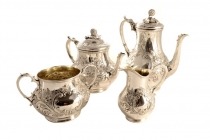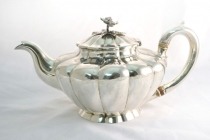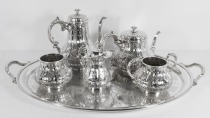Antique English Silver at Regent Antiques
Antique English silver – beautiful designs – superb craftsmanship and a solid investment.
 From cutlery to candelabra our wonderful range of desirable antique English silver offers something really special for collectors.
From cutlery to candelabra our wonderful range of desirable antique English silver offers something really special for collectors.
With stock markets still volatile and the prospects for sustained economic growth still uncertain it makes great sense to invest in something which is both beautiful and has real intrinsic value. English antique silver can give you a reliable investment and a desirable and special piece.
Early pieces – the 17th century
Much 17th century English silverware is relatively light weight as silver was in quite short supply during this period. English silversmiths of the time were often heavily influenced by Hugenot craftsmen working in England. Paul de Lamerie and Pierre Harache developed distinctive styles during the late 17th century and their work is highly sought after today.
18th century – rococo splendour
In the 18th century pieces became heavier and more ornate with plainer pieces giving way to highly elaborate rococo silverware. Then at the end of the century the fashion for quieter neo-classical work became established.
The Victorian period
In the 19th century great emphasis was placed on weight which became synonymous with quality. The Victorians were fond of intricate and complicated pieces such as highly decorative cutlery.
Leading English silversmiths
Paul de Lamerie 1688-1751. A Huguenot immigrant from France very well known for his superb English Rococo style silverware.
Matthew Boulton 1728-1809 and John Fothergill started a factory in Birmingham in 1762 (which continued trading until the mid-19th century). They produced beautiful silver and Sheffield plate domestic pieces, specialising in the Neoclassical Adam style.
Hester Bateman 1761-1793. A very successful London silversmith of the late 18th century with a legacy of highly regarded and sought after tea and coffee pots, spoons, and other domestic wares.
Paul Storr 1771-1844 – Paul Storr was involved with several successful silverware partnerships and is especially associated with for the Crown-appointed Rundell, Bridge & Rundell.
Liberty & Co from 1875 – One of London’s leading department stores Liberty’s has always championed artistic innovation especially in the Arts and Crafts and Art Nouveau styles. Important designers who worked with Liberty’s included Archibald Knox, Jessie M King and Oliver Baker. Liberty’s Cymric silverware range, produced from the early 1900s, is now highly collectable.
Marks and identification
Antique English silver is very comprehensively marked making identification relatively easily. There are at least four symbols – the sterling mark guarantees the purity of the silver – the town mark shows the location of the assay office – a date mark – and a maker’s mark.
In addition to these basic four marks others marks maybe included such as a sovereign’s head which denotes that tax was paid on the original silver. When examining hallmarks beware of “marriages” where for example a valuable hallmarked base may have been “married” to a less valuable handle. Also make sure to look out for signs of damage, repair or over harsh cleaning.
There is vast and interesting range of styles, periods and types of antique English silver on the market for the collector today. Pieces may range from a £75 early 20th century Edwardian calling card case to a fabulous and rare early 19th century Paul Storr cruet set for at least £12,000.
Beautiful and substantial plates, cutlery, tureens, cruet sets, baskets, bowls, candlesticks, pots, jugs, dishes, salvers and Monteiths are all waiting to be discovered from the small and simple to the stunning highly decorative. Please go to our website www.regentantiques.com or email or call for details of Regent Antiques current stock of antique English silver.

